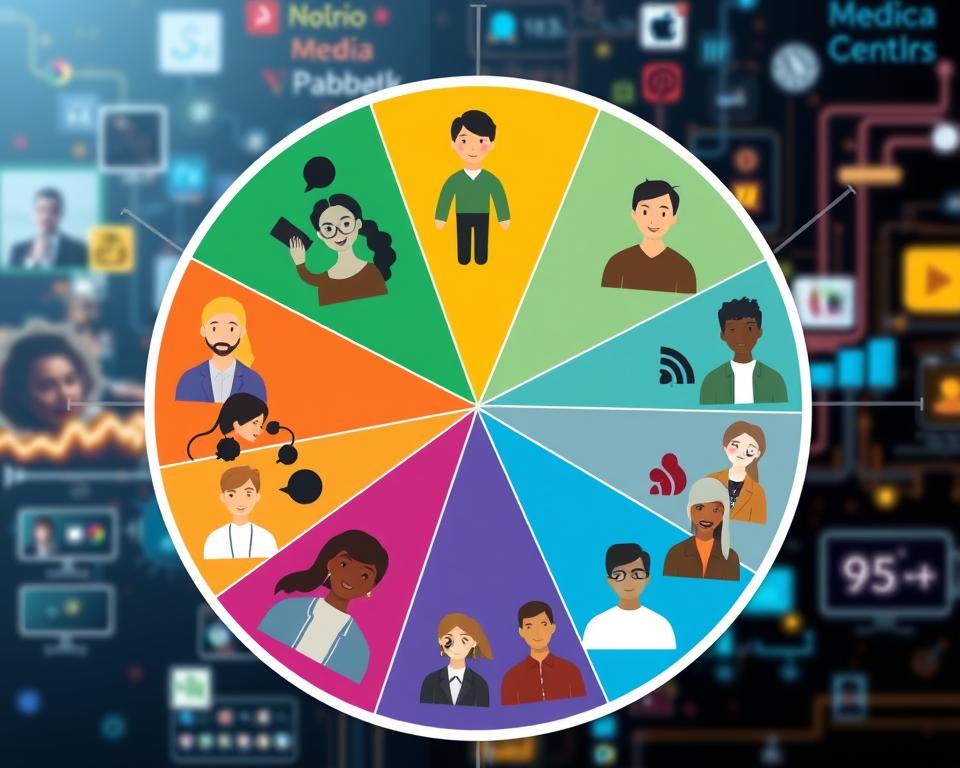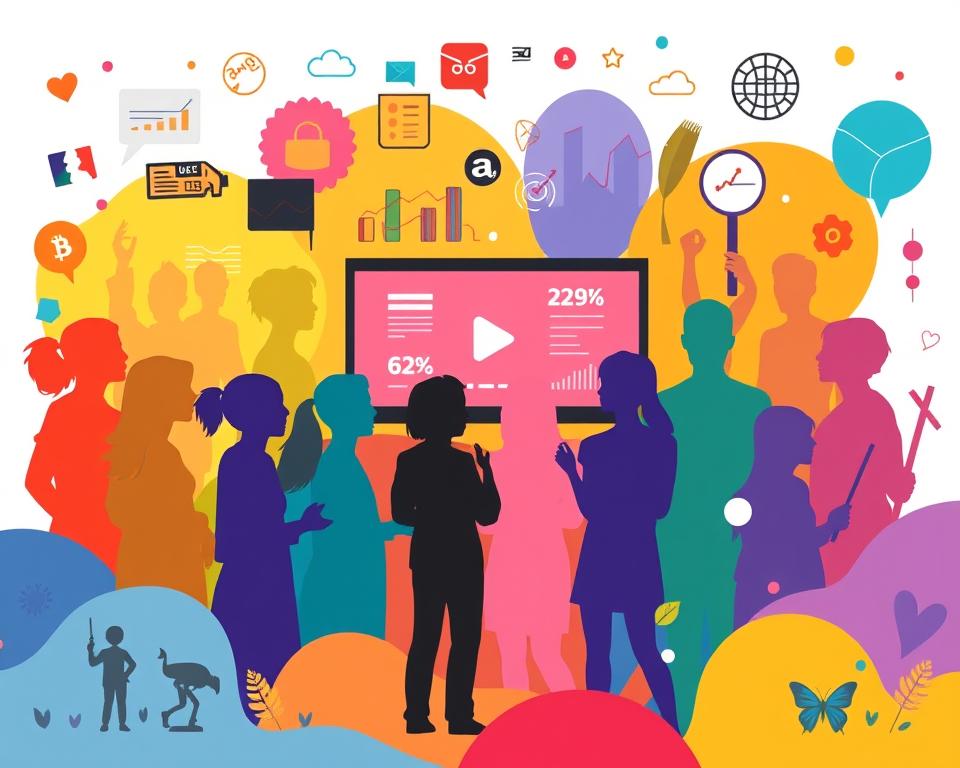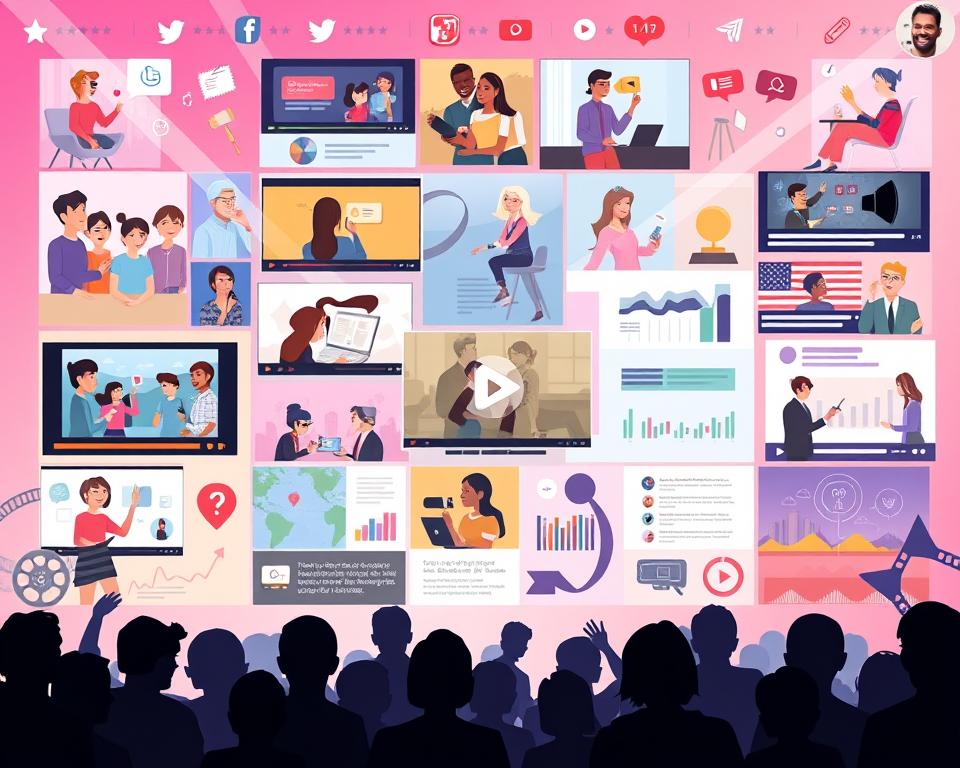More than 85% of businesses use video in their marketing. Tailoring video content for different audience groups is key to success. I’ve learned that understanding how to reach various demographics is vital for any business. This article will guide you on creating video content that appeals to diverse groups and the role of demographic targeting in video marketing.
Introduction to Demographic Targeting.
Exploring demographic targeting, I’ve found it’s about creating content that speaks to specific groups. Tailoring video content for different demographics can boost engagement and sales. This article will cover strategies for creating effective video content for diverse audiences and how to develop a winning video marketing strategy.
Key Takeaways.
- Understanding audience demographics is key for effective video content
- Demographic targeting can increase engagement and boost conversions
- A successful video marketing strategy requires tailor video content for different audience demographics
- Businesses can use data and analytics to inform their demographic targeting strategy
- Creating content that resonates with specific groups is key to driving sales and revenue
- Developing a complete video marketing strategy is essential for businesses looking to make an impact
Understanding Audience Demographics.
To make great video content, knowing your audience is key. This means doing audience segmentation. It helps you find and talk to specific groups in your audience. This way, you can make content that really speaks to them.
When it comes to target demographics, age, gender, location, and interests matter a lot. For example, videos for younger people might focus on what’s trending and social media. Videos for older folks might stick to more classic themes and ways of sharing.

Understanding Audience Demographics.
Some important things to think about when understanding your audience include:
- Age: What age range are you aiming for?
- Gender: Are there certain gender-based interests you should cover?
- Location: How do different places affect what your audience likes?
- Interests: What topics or themes do your audience care about?
By looking into these areas and using them in your content plan, you can make videos that really connect with your audience. This leads to better results and a good return on your investment.
Creating Audience Personas.
To make effective personalized video content, knowing your target audience is key. You need to create audience personas, which are detailed profiles of your ideal viewers. By doing a deep dive into audience analysis, you can find out what they like and how they behave. This helps you make content that meets their needs.
When making audience personas, think about age, location, interests, and how they watch videos. This info lets you create content that speaks to them and gets them involved. For example, if your persona is a young adult in the city, your videos might be about city life, fun, or lifestyle.

Step-by-Step Persona Development.
To make your audience personas, follow these steps:
- Research your target audience using surveys, focus groups, or social media analytics
- Identify key demographic factors, such as age, location, and interests
- Analyze their viewing habits, including preferred platforms and content types
- Create detailed profiles of your ideal viewers, including their preferences and behaviors
Aligning Content with Persona Preferences.
After you’ve made your audience personas, you can match your content to what they like. This means making personalized video content that talks to their interests, needs, and problems. Doing this boosts engagement, increases conversions, and builds a strong bond with your audience.
Adapting Video Content by Demographic.
To reach different audience groups, it’s key to adapt video content. This means understanding what each group likes and tailoring content for them.
When making videos, age matters a lot. Young people like quick, short videos. Older folks might enjoy longer, more detailed ones. It’s also important to adjust content for different cultures and places. What works in one place might not work in another.
Age-Specific Strategies.
- Use language and images that appeal to your target age group.
- Make content that meets the specific needs and interests of your age group.
- Choose music and sound effects that fit your age group.
By using demographic targeting and optimizing video content, creators can do better. They can connect more with their audience. Understanding your audience well is key to success.
Cultural and Localization Adjustments.
Adjusting content for culture and location is important. It means making videos that feel real and relatable to your audience. This includes using local language, images, and music.
Platform-Specific Video Strategies.
Understanding each platform’s unique features is key for a good video marketing plan. Different social media sites have their own users, likes, and ways of using the internet. This means you need to tailor your videos for each site to get the best results.
YouTube is great for longer videos like tutorials and educational content. It lets you dive deep into topics. But, TikTok and Instagram are perfect for short, catchy videos. They use short clips to grab people’s attention quickly.
Optimizing Content for Each Platform.
To make your videos work best on each site, follow these tips:
- Use the right keywords and tags to help people find your videos
- Write catchy titles and descriptions to draw viewers in
- Use special features like Instagram Reels or YouTube Live
Knowing what each platform is good at and adjusting your videos can really help. It’s not just about reaching more people. It’s about connecting with them in a way that matters. A video strategy that fits each platform is key to success.
Measuring Success and Iterating.
To make sure your video content strategy works, you need to track its success and make changes as needed. This means watching key metrics to see how your audience likes your videos. By looking at these numbers, you can make your content more appealing to your target audience.
Important metrics include views, engagement, and conversion rates. Views show how many people watch your video. Engagement metrics like likes, comments, and shares show how people interact with your content. Conversion rates tell you how many viewers do what you want them to, like buying something or signing up for a newsletter.
To improve your videos, try A/B testing different parts like titles, thumbnails, and formats. This means making two versions of your video and seeing which one works better. By using A/B testing, you can keep making your content better to meet your audience’s needs.
By watching key metrics and testing different versions of your videos, you can make your strategy more effective. This will help you create content that really speaks to your audience and meets your marketing goals.
| Metric | Description |
|---|---|
| Views | Number of people watching your video |
| Engagement | Likes, comments, shares, and other interactions |
| Conversion Rates | Number of viewers who take a desired action |
Tools and Resources for Demographic Targeting.
To make a video marketing strategy work, you need the right tools and resources. Demographic targeting needs a deep understanding of your audience. The right software can help you get this understanding. Adobe Premiere and Final Cut Pro are popular for video editing.
Analytics platforms are also key for tracking your video marketing strategy’s success. Google Analytics is a powerful tool. It gives insights into your audience’s behavior and preferences. This helps you improve your demographic targeting.
- Market research reports.
- Social media listening tools.
- Customer relationship management (CRM) software.
Using these tools and resources, you can make a video marketing strategy. It will target your desired demographic and increase engagement.
| Tool | Description |
|---|---|
| Adobe Premiere | Video editing software |
| Google Analytics | Analytics platform |
Case Studies and Examples.
Learning from successful case studies and examples is a great way to understand how to apply demographic targeting in practice. We will discuss how brands have successfully tailored their content to specific demographics. This focuses on demographic-driven content creation and audience engagement.
Nike’s localized campaigns are a great example. They have been highly successful in engaging with specific demographics. By creating content that resonates with local cultures and preferences, Nike has increased brand awareness and loyalty.
Nike’s Localized Campaigns.
Nike’s localized campaigns show how demographic-driven content creation can engage specific audiences. By tailoring content to local cultures and preferences, Nike has boosted brand awareness and loyalty.
Netflix’s Demographic-Driven Trailers.
Netflix’s demographic-driven trailers are another example. They increase audience engagement through targeted content creation. By making trailers for specific demographics, Netflix has boosted engagement and viewership.
These case studies highlight the importance of demographic-driven content creation and audience engagement in successful marketing campaigns. Tailoring content to specific demographics can increase engagement, drive viewership, and boost sales.
Avoiding Common Mistakes.
Targeting specific demographics can be tricky. It’s easy to make mistakes that hurt your content’s impact. Understanding audience segmentation is key. This means dividing your audience into groups based on things like age, location, or interests.
One big mistake is treating all audiences the same. This can make your content fail to connect with anyone. Instead, focus on creating content for specific audience segments. For example, use TikTok or Instagram to reach younger people.
Another important thing is making sure your content is accessible. If you ignore accessibility, you might miss out on reaching some of your audience. To avoid this, use closed captions, subtitles, and audio descriptions. This makes your content available to more people, including those with disabilities.
Here are some tips to avoid common mistakes in demographic targeting:
- Do thorough research on your target demographics.
- Create content that fits specific audience segments.
- Make sure your content is accessible with closed captions, subtitles, and audio descriptions.
By following these tips, you can make content that really speaks to your target demographics. Always keep your audience in mind. Aim to create content that is inclusive, accessible, and engaging.
Future Trends in Demographic Targeting.
Exploring the future of demographic targeting is exciting. I’m looking at new trends that will change video marketing. AI-driven personalization is a big deal. It lets marketers make content that really speaks to certain groups.
This tech is key for better targeting. It helps brands reach their audience in a more meaningful way.
Voice search and video SEO are also on the rise. With more people using voice-activated devices, marketers must adjust. Optimizing videos for voice search can help brands reach more people.
Key Trends to Watch.
- AI-driven personalization will become a cornerstone of demographic targeting, enabling marketers to create highly targeted content.
- Voice search and video SEO will gain prominence, requiring marketers to adapt their video marketing strategy to accommodate this shift.
- Demographic targeting will become even more precise, allowing brands to connect with their target audiences more effectively.
By embracing these trends, brands can stay ahead. They can achieve more in demographic targeting. Marketers must stay flexible and keep up with new trends.
Conclusion.
Tailoring video content to diverse audience demographics is key to a good video marketing strategy. Understanding your audience well helps you make videos that really connect. This approach boosts engagement and makes your content more impactful.
As technology advances, we’ll see more chances to personalize and optimize videos with AI. This means we can offer even more tailored experiences to our viewers.
Success comes from always learning, testing, and improving. Keep up with new trends and use data tools to guide you. By focusing on your audience, you can make your videos more effective and increase your return on investment.


0 Comments